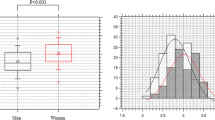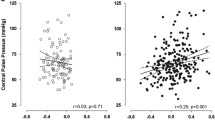Abstract
Arterial stiffness is involved in the pathophysiology of cardiovascular disease, and the degree of arterial stiffness is associated with the extent of vascular calcification. This study aimed to investigate the association of hair calcium levels with augmentation index (AIx), a simple, non-invasive measurement for arterial stiffness. Healthy Koreans (male, n = 34, female, n = 70) were enrolled in this study. Anthropometric parameters, lipid profiles, fasting glucose, hair mineral levels, and AIx were measured. Pearson/partial correlations and multivariate linear regression analyses were used to assess the relationship between hair calcium levels and AIx. AIx positively correlated with hair calcium levels (r = 0.275, p = 0.005), age (r = 0.283, p = 0.004), systolic blood pressure (r = 0.282, p = 0.004), low-density lipoprotein (LDL)-cholesterol (r = 0.255, p = 0.009), and hair magnesium (r = 0.196, p = 0.046), and negatively correlated with heart rate (r = -0.563, p < 0.001) and fasting glucose (r = -0.262, p = 0.005). Hair calcium levels significantly correlated with hair magnesium (r = 0.926, p < 0.001). Significant relationship between AIx and hair calcium levels was maintained after adjustment for sex, age, height, hear rate, blood pressure, total cholesterol, LDL-cholesterol, fasting glucose, and hair magnesium (r = 0.244, p = 0.018). Logistic regression model showed that AIx increased with the increment of hair calcium levels; log-AIx increased by 0.403% (95% CI: 0.139–0.515, p = 0.001) per unit change in log-hair calcium level (sex-adjusted). After adjustment for all the variables above together with triglyceride and high-density lipoprotein-cholesterol, increased significance of the association was 0.513% (p = 0.016)]. This study supports the presence of the independent positive relationship between hair calcium levels and AIx. It suggests the possibility that hair calcium levels may be a useful index for reflecting arterial stiffness.

Similar content being viewed by others
References
Duprez DA, Cohn JN (2007) Arterial stiffness as a risk factor for coronary atherosclerosis. Curr Atheroscler Rep 9:1329–1344
Matsuoka O, Otsuka K, Murakami S et al (2005) Arterial stiffness independently predicts cardiovascular events in an elderly community—longitudinal investigation for the longevity and aging in Hokkaido county (LILAC) study. Biomed Pharmacother 59:S40–S44
Laurent S, Boutouyrie P, Asmar R et al (2001) Aortic stiffness is an independent predictor of all-cause and cardiovascular mortality in hypertensive patients. Hypertension 37:1236–1241
Van Popele NM, Grobbee DE, Bots ML et al (2001) Association between arterial stiffness and atherosclerosis: the Rotterdam study. Stroke 32:454–460
DeLoach SS, Townsend RR (2008) Vascular stiffness: its measurement and significance for epidemiologic and outcome studies. Clin J Am Soc Nephrol 3:184–192
Safar ME, London GM (2000) Therapeutic studies and arterial stiffness in hypertension: recommendations of the European Society of Hypertension. The Clinical Committee of Arterial Structure and Function. Working Group on Vascular Structure and Function of the European Society of Hypertension. J Hypertens 18:1527–1535
Blacher J, Safar ME, Guerin AP et al (2003) Aortic pulse wave velocity index and mortality in end-stage renal disease. Kidney Int 63:1852–1860
Keelan PC, Bielak LF, Ashai K et al (2001) Long-term prognostic value of coronary calcification detected by electron-beam computed tomography in patients undergoing coronary angiography. Circulation 104:412–417
Guerin LGM, AP MSJ et al (2003) Arterial media calcification in end-stage renal disese: impact on all-cause and cardiovascular mortality. Nephrol Dial Transplant 18:1731–1740
Kullo IJ, Bielak LF, Turner ST, Sheedy PF 2nd, Peyser PA (2006) Aortic pulse wave velocity is associated with the presence and quantity of coronary artery calcium: a community-based study. Hypertension 47:174–179
Abedin M, Tintut Y, Demer LL (2004) Vascular calcification: mechanisms and clinical ramifications. Arterioscler Thromb Vasc Biol 24:1161–1170
Shao J-S, Towler DA (2006) Molecular mechanisms of vascular calcification: lessons learned from the aorta. Arteioscler Thromb Vasc Biol 26:1423–1430
Song Ch, Barret-Cornor E, Chung JH, Kim SH, Kim KS (2007) Associations of calcium and magnesium in serum and hair with bone mineral density in premenopausal women. Biol Trace Elem Res 118:1–9
MacPherson A, Basco J (2000) Relationship of hair calcium concentration to incidence of coronary heart disease. Sci Total Environ 225:11–19
Tall MW, Siqrist MK, Fakis A, Fluck RJ, McIntyre CW (2007) Markers of arterial stiffness are risk factors for progression to end-stage renal disease among patients with chronic kidney disease stages 4 and 5. Nephron Clin Pract 107:177–181
Li JJ, Zhu CG, Yu B, Liu YX, Yu MY (2007) The role of inflammation in coronary artery calcification. Ageing Res Rev 6:263–270
van Bortel LM, Duprez D, Starmans-Kool MJ et al (2002) Clinical applications of arterial stiffness, Task Force III: recommendations for user procedures. Am J Hypertens 15:445–452
Avolio AP, O’Rourke MF (2003) Applicability and benefit of arterial transfer functions. J Hypertens 21(11):2199–2200
Chen CH, Nevo E, Fetics B et al (1997) Estimation of central aortic pressure waveform by mathematical transformation of radial tonometry pressure. Validation of generalized transfer function. Circulation 95:1827–1836
Bermejo Barrera P, Lorenzo Alonso MJ, Bermejo Barrera A et al (2000) Selenium determination in mother and child’s hair by electrothermal atomic absorption spectrometry. Forensic Sci Int 10:149–156
Budoff MJ et al (2005) Diabetes and progression of coronary calcium under the influence of statin therapy. Am Heart J 149:695–700
Block GA, Spiegel DM, Ehrlich J et al (2005) Effects of sevelamer and calcium on coronary artery calcification in patients new to hemodialysis. Kidney Int 68:1815–1824
Kiel DP, Kauppila LI, Cupples LA, Hannan MT, O’Donnell CJ, Wilson PW (2001) Bone loss and the progression of abdominal aortic calcification over a 25 year period: the Framingham heart study. Calcif tissue Int 68:271–276
Detrano RC, Wong ND, Doherty TM, Shavelle R (1997) Prognostic significance of coronary calcific deposits in asymptomatic high-risk subjects. Am J Med 102:344–349
Raggi P, Callister TQ, Cooil B et al (2000) Identification of patients at increased risk of first unheralded acute myocardial infarction by electron-beam computed tomography. Circulation 101:850–855
Jeziorska M, McCollum C, Wooley DE (1998) Observations on bone formation and remodeling in advanced atherosclerotic lesions of human carotid arteries. Virchows Arch 433:559–565
Naves M, Rodriguez-Garcia M et al (2008) Progression of vascular calcifications is associated with greater bone loss and increased bone fractures. Osteoporosis Int 19:1161–1166
Riggs BL, Melton LJ III (1986) Involutional osteoporosis. N Engl J Med 314:1676–1686
Matsunaga S, Ito H, Sakou T (1999) The effect of vitamin K and D supplementation on ovarectomy-induced bone loss. Calcif Tissue Int 65:285–289
Hauschka PV, Carr SA (1982) Calcium-dependent a-helical structure in osteocalcin. Biochemistry 21:2538–2547
Iwamoto J, Takeda T, Ichimura S (2000) Effect of combined administration of vitamin D3 and vitamin K2 on bone mineral density of the lumbar spine in postmenopausal women with osteoporosis. J Orthop Sci 5:546–551
Price PA (1985) Vitamin K-dependent formation of bone Gla protein (osteocalcin) and its function. Vitam Horm 42:65–108
Luo G, Ducy P, McKee MD et al (1997) Spontaneous calcification of arteries and cartilage in mice lacking matrix GLA protein. Nature 386:78–81
Yagami K, Suh JY, Enomoto-Iwamoto M et al (1999) Matrix GLA protein is a developmental regulator of chondrocyte mineralization and, when constitutively expressed, blocks endochondral and intramembranous ossification in the limb. J Cell Biol 147:1097–1108
Price PA, Faus SA, Williamson MK (1998) Warfarin causes rapid calcification of the elastic lamellae in rat arteries and heart valves. Arteriosler Thromb Vasc Biol 18:1400–1407
Braam LA, Dissel P, Gijsbers BL et al (2000) Assay for human matrix Gla protein in serum. Arteoscler Thromb Vasc Biol 20:1257–1261
Disclosure
There is no potential conflict of interest.
Author information
Authors and Affiliations
Corresponding author
Rights and permissions
About this article
Cite this article
Kim, O.Y., Baek, S.H., Lee, Y.J. et al. Association of Increased Hair Calcium Levels and Enhanced Augmentation Index (AIx): a Marker of Arterial Stiffness. Biol Trace Elem Res 138, 90–98 (2010). https://doi.org/10.1007/s12011-010-8619-z
Received:
Accepted:
Published:
Issue Date:
DOI: https://doi.org/10.1007/s12011-010-8619-z




